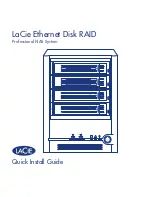
All switches were not created equal
For anyone installing a local area network, the choice of
network fabric is obvious. Ethernet is the only show in town.
But when it comes installing the active devices that connect
the workstations, PCs and servers, the choices are less clear-
cut. The market boasts a plethora of devices each claiming to
be the simplest to install, fastest to run, easiest to manage and
the most secure to protect your network from costly downtime.
So how do you decide? Luckily SMC can help. SMC makes
it easy to understand the many different standards and
protocols to make the right decision for your network.
Combining the latest innovation with over 30 years’ design
experience, SMC gives you the best solutions on the market.
It’s simple – it’s Ethernet!
Since its development in the early 1980s by Digital Equipment
Corporation, Intel and Xerox, Ethernet has become the de-
facto physical layer standard for local area networking. In
that time, it has progressed from a 10 Mbps shared broadcast
system running over thick coaxial cable to 10 Gbps running
full duplex over fi bre optic cables. It is also supported on
unshielded twisted pair copper cabling, telephone cabling and
most recently, over wireless networks.
Ethernet has kept pace with the phenomenal improvements in
performance that we have seen in computers and information
technology. Each major iteration of the Ethernet standard
has increased the speed ten-fold and added more physical
media types such as fi bre and copper. Not only that, complete
compatibility has been maintained for computer and network
device connections ensuring no major equipment upgrades are
required to use the new higher speeds.
The last major Ethernet transition occurred in the late 1990s
when 100 Mbps Ethernet was deployed to the desktop to replace
the older 10 Mbps connections. In tandem, Gigabit Ethernet
was deployed in network backbones to aggregate the extra
100 Mbps feeds. Now another major transition is taking place.
The price of Gigabit Ethernet has fallen to the point where it is
being deployed to the desktop. The latest 10 Gigabit standard is
starting to appear in data centre backbones and is expected to
emerge in enterprise LANs over the next 2-3 years. Many PC and
laptop vendors are now shipping Gigabit Ethernet interfaces as
standard. As the latest IDC Ethernet port forecasts in Figure 1
indicate, the time is right to plan the next migration - and to
update switching infrastructures in readiness to exploit it.
Why managed switches?
The €30 Ethernet switch that you can now buy in any
computer hardware store is typically an unmanaged device.
Whilst it is fi ne for connecting a few PCs and laptops in a
home environment, it is not appropriate for use in a company
network with many PCs and servers. For these environments
a managed switch is essential to give the required levels of
control, network performance, security and reliability.
Modern managed switches can provide all these functions using
standard techniques such as VLANs, Port Trunking, security,
prioritization, fi ltering and SNMP network management.
VLANs
The great thing about Ethernet is that it is plug-and-play: just
plug the devices into a switch and they will fi nd each other and
start communicating. The downside of this is that Ethernet is
very chatty - it broadcasts a lot of messages to every device
connected to the switch. For a 4 port switch this is not a
problem. But start to connect 40, 400 or 4000 devices and
the amount of broadcast traffi c can begin to seriously slow
down and degrade the network.
To cut down on the amount of broadcast traffi c, you can create
Virtual LANs (VLANs) which operate as separate broadcast
domains. This means that members of a VLAN can only talk
directly to other members of the VLAN as shown in Figure 2.
If members of different VLANs need to communicate, then a
router is required. A router uses Layer 3 IP addresses to forward
packets to the correct destination. Most modern Ethernet
switches combine these two functions in the same device which
is often known as a switch/router or Layer 3 Switch.
Table 1: Types of Ethernet
Figure 1: Ethernet ports shipped forecast 2002-2008
Figure 2: Ethernet VLAN Switching
Type
Speed
IEEE
Standard
Media
Types
PHY Type
Ethernet
(CSMA/CD)
10 Mbps
802.3
Coaxial
Thinwire
UTP
10Base-5
10Base-2
10Base-T
Fast
Ethernet
100 Mbps
802.3u
UTP
Fibre
100Base-TX
100Base-FX
Gigabit
Ethernet
1000 Mbps
802.3ab/z
Fibre
UTP
1000Base-SX/LX
1000Base-CX
10 Gigabit
Ethernet
10000 Mbps
802.3ae
Fibre
SDH
10GBase-R
10GBase-W
Wireless
Ethernet
or Wi-Fi
11 Mbps
54 Mbps
802.11b
802.11g
802.11a
Radio
Frequency
DSSS
DSSS/OFDM
OFDM






















